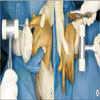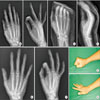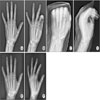Abstract
Purpose
The purpose of the present study was to verify the therapeutic efficiency of modified percutaneous retrograde intramedullary fixation using Kirschner wire in metacarpal shaft and neck comminuted fractures.
Methods
A total of 17 cases in 15 patients with metacarpal shaft and neck comminuted fractures diagnosed by physical examination and imaging modalities were included. For radiologic evaluations, the changes of degree of metacarpal bone shortening and that of dorsal angulation of metacarpal bone between before and six months after surgery were measured. Clinical evaluations were assessed by the timing of clinical union and visual analog scale (VAS), total active range of motion (TAM) of metacarpophalangeal joint, and complications at six months postoperatively.
Results
In all cases, union was achieved without additional treatment. The degree of the metacarpal bone shortening and the degree of dorsal angulation of metacarpal bone were improved significantly at six months after operation. The clinical bone union was completed average 6.49 weeks after surgery. The mean VAS was 1.35, and the mean TAM of metacarpophalangeal joint was 85.88° at 6 months postoperatively. Complications including nonunion, malunion, and refracture were not observed during follow-up period.
Conclusion
Modified percutaneous retrograde intramedullary fixation using Kirschner wire showed satisfactory treatment results in metacarpal shaft and neck comminuted fractures. Thus, this method could be recommended as one of treatment modalities for metacarpal shaft and neck comminuted fractures due to its easy procedures and low occurrence rate of associate complications.
Figures and Tables
 | Fig. 1(A) Wires were inserted retrogradely using a mallet at a maximal wrist flexed position. (B) The surgeon moved the Kirschner wire to proximal side using mallet and vice grip. |
 | Fig. 2(A) Pre-operative true antero-posterior radiograph of the involved right hand of 27-year-old man with comminuted 2nd metacarpal neck fracture. (B) Pre-operative oblique radiograph of the hand with metacarpal neck fracture which showed dorsal angulation. (C, D) Antero-posterior and lateral view of radiographs taken immediately after operation which showed satisfactory fracture reduction. (E, F) Six-month postoperatively taken radiograph showed that complete bony union was achieved with acceptable alignment. (G, H) The patient fully recovered the range of motion of the involved hand at 6 months after the operation. |
 | Fig. 3(A, B) Pre-operative true antero-posterior and oblique radiograph of the involved left hand of 80-year-old man with comminuted 3rd metacarpal shaft fracture. (C, D) Anteroposterior and lateral view of radiographs taken immediately after operation which showed satisfactory fracture reduction. (E, F) One-year postoperatively taken radiograph showed that complete bony union was achieved with acceptable alignment. |
References
1. Chung KC, Spilson SV. The frequency and epidemiology of hand and forearm fractures in the United States. J Hand Surg Am. 2001; 26:908–915.

2. Stanton JS, Dias JJ, Burke FD. Fractures of the tubular bones of the hand. J Hand Surg Eur Vol. 2007; 32:626–636.

3. Diaz-Garcia R, Waljee JF. Current management of metacarpal fractures. Hand Clin. 2013; 29:507–518.

4. Kollitz KM, Hammert WC, Vedder NB, Huang JI. Metacarpal fractures: treatment and complications. Hand (N Y). 2014; 9:16–23.

5. Bloom JM, Hammert WC. Evidence-based medicine: metacarpal fractures. Plast Reconstr Surg. 2014; 133:1252–1260.
6. Padegimas EM, Warrender WJ, Jones CM, Ilyas AM. Metacarpal neck fractures: a review of surgical indications and techniques. Arch Trauma Res. 2016; 5:e32933.

7. Rhee SH, Lee SK, Lee SL, Kim J, Baek GH, Lee YH. Prospective multicenter trial of modified retrograde percutaneous intramedullary Kirschner wire fixation for displaced metacarpal neck and shaft fractures. Plast Reconstr Surg. 2012; 129:694–703.

8. Lee SK, Kim KJ, Choy WS. Modified retrograde percutaneous intramedullary multiple Kirschner wire fixation for treatment of unstable displaced metacarpal neck and shaft fractures. Eur J Orthop Surg Traumatol. 2013; 23:535–543.

9. Han SH, Yoon HK, Shin DE, Han SC, Kim YW. Percutaneous retrograde intramedullary pin fixation for isolated metacarpal shaft fracture of the little finger. J Korean Fract Soc. 2010; 23:367–372.

10. Moon CS, Jeon HS, Jeon SJ, Seo YR, Noh HK. Treatment of metacarpal shaft fractures with retrograde intramedullary Kirschner-wire fixation. J Korean Soc Surg Hand. 2010; 15:1–7.
11. Kellam JF, Meinberg EG, Agel J, Karam MD, Roberts CS. Introduction: fracture and dislocation classification compendium-2018: International Comprehensive Classification of Fractures and Dislocations Committee. J Orthop Trauma. 2018; 32:Suppl 1. S1–S10.
12. Hand and carpus. J Orthop Trauma. 2018; 32:Suppl 1. S83–S88.
14. Shimizu T, Omokawa S, Akahane M, Murata K, Nakano K, Kawamura K, et al. Predictors of the postoperative range of finger motion for comminuted periarticular metacarpal and phalangeal fractures treated with a titanium plate. Injury. 2012; 43:940–945.

15. Cooney WP 3rd, Dobyns JH, Linscheid RL. Complications of Colles' fractures. J Bone Joint Surg Am. 1980; 62:613–619.

16. Omokawa S, Fujitani R, Dohi Y, Okawa T, Yajima H. Prospective outcomes of comminuted periarticular metacarpal and phalangeal fractures treated using a titanium plate system. J Hand Surg Am. 2008; 33:857–863.

17. Agashe MV, Phadke S, Agashe VM, Patankar H. A new technique of locked, flexible intramedullary nailing of spiral and comminuted fractures of the metacarpals: a series of 21 cases. Hand (N Y). 2011; 6:408–415.

18. Sung YG, Song SW, Lee YM. Modified bouquet technique for treatment of metacarpal neck fractures. J Korean Soc Surg Hand. 2016; 21:137–143.

19. Fusetti C, Meyer H, Borisch N, Stern R, Santa DD, Papaloïzos M. Complications of plate fixation in metacarpal fractures. J Trauma. 2002; 52:535–539.

20. Crowley TP, Stevenson S, Taghizadeh R, Addison P, Milner RH. Early active mobilization following UCL repair with Mitek bone anchor. Tech Hand Up Extrem Surg. 2013; 17:124–127.

21. Kim JY, Lee YK, Kong GM, Kim DY, Park JH, Jung YR. Comparison of intramedullary K-wire nailing versus plate for fixation in metacarpal midshaft fracture. J Korean Orthop Assoc. 2016; 51:338–344.

22. Black D, Mann RJ, Constine R, Daniels AU. Comparison of internal fixation techniques in metacarpal fractures. J Hand Surg Am. 1985; 10:466–472.





 PDF
PDF ePub
ePub Citation
Citation Print
Print






 XML Download
XML Download